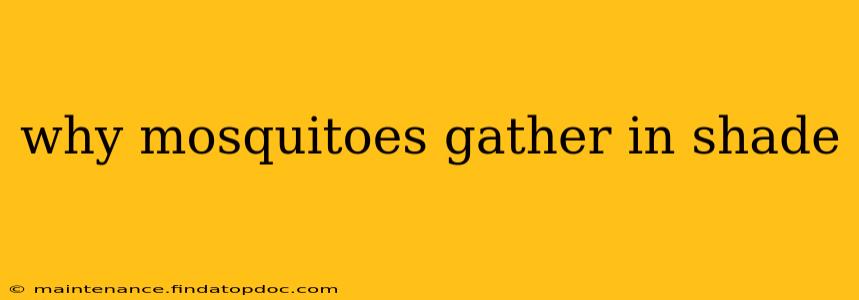Mosquitoes, those tiny bloodsuckers, are notorious for their annoying buzzing and itchy bites. But why do they seem to congregate in shady areas? Understanding their behavior requires delving into their biology and environmental preferences. This isn't just about annoying pests; it's about understanding the ecological factors that influence their population dynamics.
Why Do Mosquitoes Prefer Shade? A Look at the Science
Mosquitoes are ectothermic, meaning they rely on external sources to regulate their body temperature. Direct sunlight can overheat them, potentially leading to dehydration and death. Shady areas offer a crucial refuge from the harsh sun's rays, allowing them to maintain a comfortable body temperature and conserve energy. This is a primary reason why they're drawn to shaded areas.
Think of it like this: Imagine yourself on a hot summer day. You'd naturally seek out the shade of a tree to cool down. Mosquitoes have a similar need, albeit with much more severe consequences for exposure to intense heat.
What Other Factors Attract Mosquitoes to Shady Areas?
While temperature regulation is a major driver, other factors contribute to mosquito congregation in shaded areas:
Increased Humidity:
Shaded areas often maintain higher humidity levels than sun-drenched spots. This higher humidity helps prevent the mosquitoes from drying out, which is vital for their survival. Their delicate bodies are susceptible to desiccation, and shade provides a more humid microclimate.
Protection from Predators:
The dense vegetation and cover provided by shady areas offer protection from predators like birds and bats. These predators rely on sight to locate their prey, and the shadowy environment makes mosquitoes harder to detect.
Breeding Grounds:
Mosquitoes often breed in still, standing water found in shaded areas like puddles, ditches, and clogged gutters. These shaded environments provide the ideal conditions for their eggs to hatch and larvae to develop.
How Does Shade Affect Mosquito Activity Levels?
The relationship between shade and mosquito activity is complex. While shade provides refuge and favorable conditions, it doesn't necessarily mean constant high activity. Mosquito activity is influenced by a combination of factors, including:
- Time of Day: Mosquitoes are most active during dawn and dusk, regardless of shade.
- Temperature: Even in shady areas, excessively high or low temperatures can impact their activity levels.
- Wind: Wind can affect their flight patterns and make it more difficult to find hosts.
- Rainfall: Rainfall can create breeding grounds and increase mosquito populations, regardless of shade.
Are There Specific Types of Mosquitoes More Likely to Be Found in Shade?
While most mosquito species benefit from shaded areas, some might show a stronger preference than others. The specific species prevalent in a region and their individual tolerances to environmental factors will dictate their behavior. Further research on specific species would be required for a conclusive answer.
How Can I Protect Myself from Mosquitoes in Shady Areas?
Protecting yourself from mosquito bites in shady areas requires a multi-pronged approach:
- Use insect repellent: Apply a repellent containing DEET, picaridin, or IR3535.
- Wear protective clothing: Cover exposed skin with long sleeves and pants.
- Eliminate standing water: Remove sources of standing water in your yard, such as clogged gutters and birdbaths.
- Limit time spent outdoors during peak mosquito activity: Avoid going outside during dawn and dusk when mosquitoes are most active.
Understanding why mosquitoes are drawn to shady areas provides invaluable insight into their behavior and allows for more effective strategies to protect ourselves from their bites. By addressing the factors that make these areas attractive to them, we can better mitigate the nuisance and potential health risks posed by these insects.
